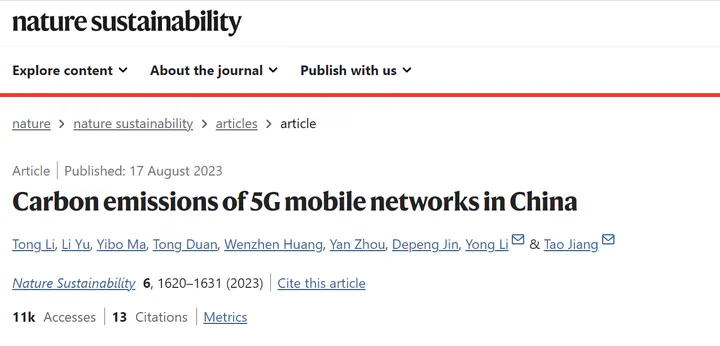🎉 Our paper was accepted by Nature Sustainability.
 Our Paper.
Our Paper.Table of Contents
Author
Tong Li, Li Yu, Yibo Ma (Me), Tong Duan, Wenzhen Huang, Yan Zhou, Depeng Jin, Yong Li (Supervisor, liyong07@tsinghua.edu.cn), Tao Jiang (taojiang@hust.edu.cn)
Abstract
5G telecommunication plays a vital role in our daily life and the global economy. However, the energy consumption and carbon emissions of 5G mobile networks are concerning. Here, we develop a large-scale data-driven framework to quantitatively assess carbon emissions of 5G mobile networks in China, where over 60% of the global 5G base stations are implemented. We reveal a carbon efficiency trap of 5G mobile networks leading to additional carbon emissions of {23.82 $\pm$ 1.07} megatons in China, caused by the spatio-temporal misalignment between cellular traffic and energy consumption in mobile networks. To address this problem, we propose an energy-saving method, called DeepEnergy, leveraging collaborative deep reinforcement learning and graph neural networks, to make it possible to effectively coordinate the working state of 5G cells, which could help over 71% of Chinese provinces avoid carbon efficiency traps. The application of DeepEnergy can potentially reduce {20.90 $\pm$ 0.98} megatons of carbon emissions at the national level in 2023. Furthermore, the mobile network in China could accomplish more than 50% of its net-zero goal by integrating DeepEnergy with solar energy systems. Our study deepens the insights into carbon emission mitigation in 5G networks, paving the way towards energy-efficient and sustainable telecommunication infrastructures.
Data
The numbers of base stations and mobile users in each province are listed in Supplementary Tables 3 and 4. The network traffic data and the number of mobile users in Nanchang are listed in Supplementary Table 2. Source data are provided with this paper.
Code
We have made our code publicly available on GitHub.
Acknowledgements
This research has been supported in part by the National Key Research and Development Program of China under grant no. 2020YFA0711403 to D.J., by the National Natural Science Foundation of China under grant no. U21B2036 to T.J., by the National Natural Science Foundation of China under grant no. 61971267 to Y.L., and the International Postdoctoral Exchange Fellowship Program (Talent Introduction Program) under Project YJ20210274 to T.L. The individuals or organizations who provided funding had no role in study design, data collection, analysis, publication decision or preparation of the paper. We also thank the China Mobile Research Institute for Jiutian platform support and the China Mobile Group Jiangxi Company for data support.